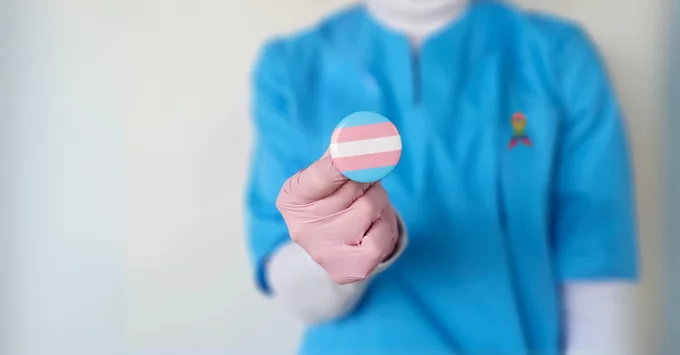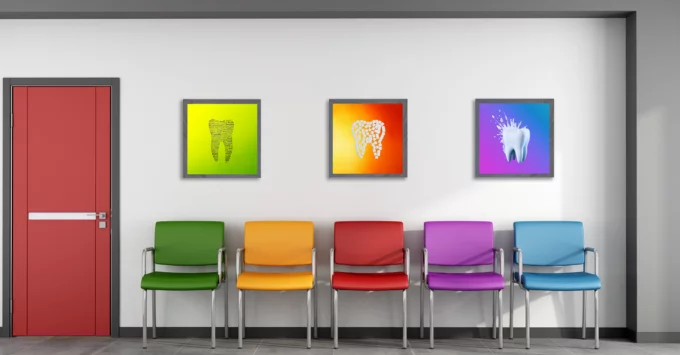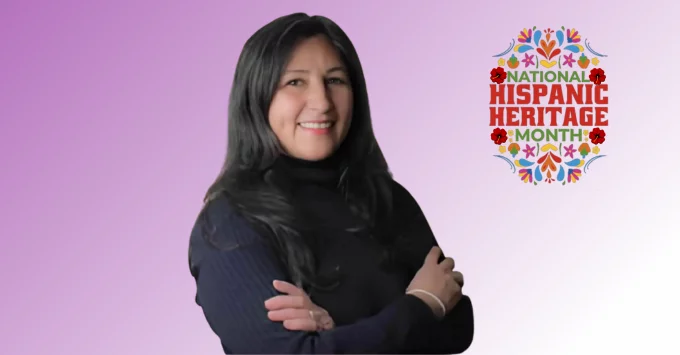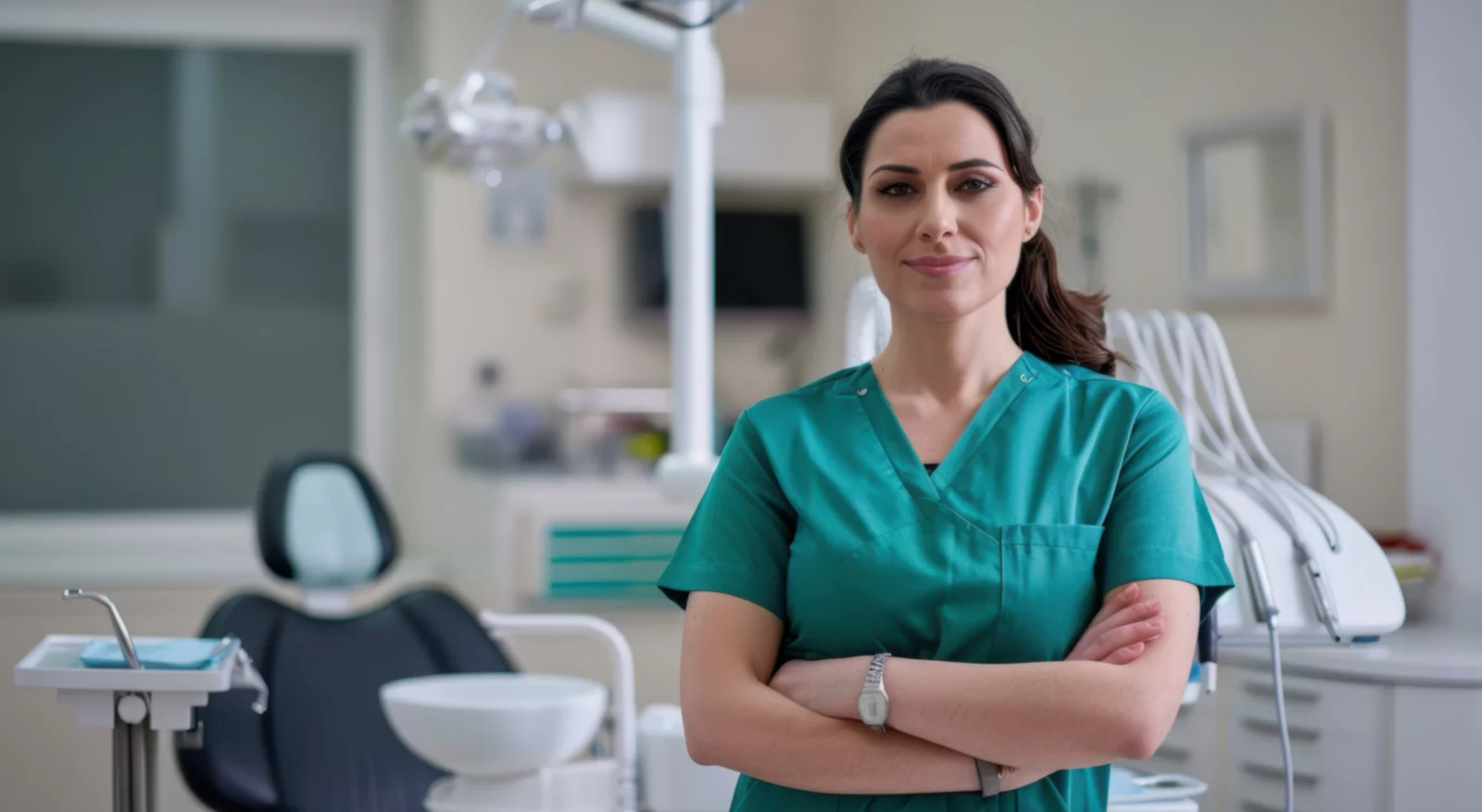By Amanda Berthiaume, MsDH, RDH, CDA, FADHA and Amanda Hill, BSDH, RDH, CDIPC
June 2, 2025
What I love most about dental hygiene is the diversity of the patients I serve and the variety of experiences each day brings. I take more continuing education courses than I’d like to admit, always striving to be the best provider I can be. But the most transformative lesson in my career didn’t come from a classroom or clinical achievement – it came from parenting.
My child is transgender. And as they began their transition, I began my own – into deeper understanding, into active allyship, and into using my voice to promote equity in healthcare, including the dental setting.
A Personal Shift with Professional Purpose
As a mother, I watched my child grow into their authentic self with bravery that most adults only hope to achieve. As a dental professional, I quickly realized how few providers felt prepared – or even aware – of how to compassionately care for transgender patients. That gap between patient identity and provider readiness became my call to action.
I started incorporating gender diversity education into my work, speaking at conferences, creating inclusive curriculum, and developing resources for fellow clinicians. My goal was simple but urgent: to ensure that every patient, regardless of gender identity, feels seen, respected, and safe in the dental chair.1
Why Gender Identity Matters in Oral Health
 To some, the connection between gender identity and dentistry might not be immediately clear. But consider this: more than 85% of transgender individuals report having experienced maltreatment by an oral health provider.2 Many fear being misgendered, questioned about their appearance, or denied care outright.
To some, the connection between gender identity and dentistry might not be immediately clear. But consider this: more than 85% of transgender individuals report having experienced maltreatment by an oral health provider.2 Many fear being misgendered, questioned about their appearance, or denied care outright.
Additionally, gender-affirming hormone therapy can affect oral and systemic health, including increased risks for periodontal disease, osteoporosis, and dental caries. A lack of training leaves clinicians ill-equipped to anticipate or manage these outcomes, which directly affects patient care and trust.3
From Fear to Affirmation: Building Inclusive Practices
The good news? Small changes make a big difference. Creating an inclusive dental office starts with intentional, everyday actions. This includes using correct names and pronouns, incorporating inclusive language on patient forms, and ensuring all staff receive cultural competency training. Physical spaces should also reflect inclusivity – such as gender-neutral restroom signage and visible non-discrimination policies in waiting areas and online platforms. Taking the time to explain why questions about gender identity or relationship status are asked can build trust and comfort.4 Most importantly, inclusion must be a consistent effort, not a one-time initiative. When patients and team members see that their identities are respected and affirmed, it strengthens the foundation of compassionate, ethical care.
As I often say in my continuing education course, allyship isn’t about perfection – it’s about presence. It’s about showing up, being willing to learn, and acknowledging when you get it wrong so you can get it right the next time.
Supporting Patients – and Each Other
Our patients aren’t the only ones who benefit from affirmation and understanding. As an educator, I’m seeing a growing number of gender-diverse students, each at different stages of identity and affirmation. With the number of transgender and non-binary dental professionals increasing, creating safe and welcoming workplaces are in need now more than ever. While these conversations can be challenging to initiate, they are essential. Supporting marginalized communities – especially in today’s climate – requires both courage and compassion. We must foster professional environments where it is safe to advocate, educate, and grow together.
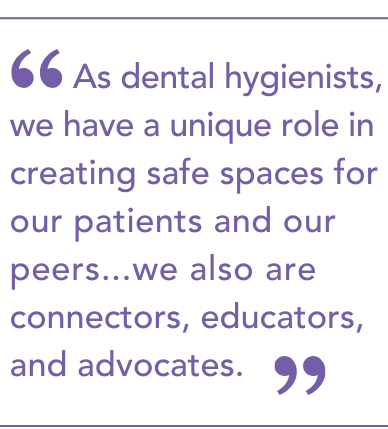 Celebrating Pride Year-Round
Celebrating Pride Year-Round
June is Pride Month, but supporting the LGBTQIA+ community must extend far beyond a flag on the wall. It’s about sustained commitment, education, and visibility. As dental hygienists, we have a unique role in creating safe spaces for our patients and our peers. We are prevention specialists – but we also are connectors, educators, and advocates.
My child taught me that identity is not a trend – it’s a truth. And from that truth, I’ve found the strength to speak up, both as a mother and as a healthcare professional. I hope you’ll join me in making our profession one where all people – regardless of how they identify – can smile without fear.
Finding Community Through Connection and Allyship
One of the things I value most about the ADHA is the relationships I’ve built through networking with fellow members. It’s incredible to connect with others who are not only passionate about dental hygiene but who also share similar personal experiences. I first met Amanda Hill at an ADHA Annual Conference a few years ago. I was immediately drawn to her energy, positivity, and deep love for the profession. As our conversation deepened, we discovered more than just a shared name – we also shared a fierce love and unwavering support for our transgender children. Her openness and strength reminded me that I am not alone. That moment created a powerful sense of allyship and a safe space that I didn’t even know I needed.
We talked recently, and this is what Amanda Hill shared. Finding someone who not only shared my name but also was walking a similar path with a transgender child, I felt an immediate bond with Amanda Berthiaume. I love how membership in ADHA helps you professionally and also personally. Amanda B. and I have been able to support one another in finding ways to help our colleagues understand dentistry’s role in gender identity and in supporting our own kids!
I often hear from our peers, “I treat everyone with respect and kindness.” And while I’m sure this feels true, understanding things like why inclusive intake forms help patients feel welcome at your office, or how using personal pronouns allows patients to open up about their medical history, or even using gender neutral language when asking patients’ questions about their families allows a mom like me to feel at ease. I remember once at the dermatologist when the nurse was chit-chatting with me, and she inquired about my daughter’s upcoming wedding and if I liked “him,” meaning her fiancé, when her fiancé is a she. It struck me how quickly I became on guard, wondering if I could be honest and if I was truly welcome in this office. Would I suggest my child see this dermatologist?
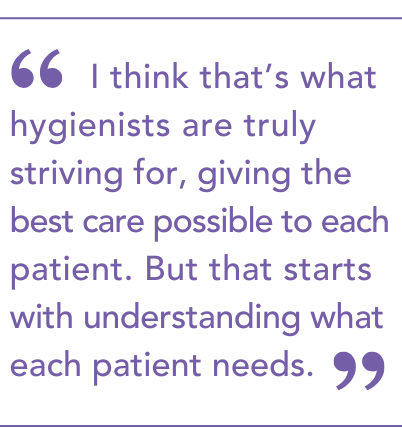
Simple shifts like these can help patients and their families feel more at ease, and they open up an opportunity for better care. And in the end, I think that’s what hygienists are truly striving for, giving the best care possible to each patient. But that starts with understanding what each patient needs. Including our gender diverse population.
Resources For Your Practice
The American Institute of Dental Public Health offers several resources you may find useful as you become an ally. Two reports of note are the Research Brief on Improving Knowledge, Comfort, and Attitudes for LGBTQIA+ Clinical Care and Dental Education and an article: How socioeconomic and structural barriers influence dental care among transgender people.
Download both and find more resources here.
____________________________________
References
1A. Berthiaume, “The Dental Professional’s Role in Gender Identity” (presentation, Yankee Dental Congress, Boston, MA, January 25, 2024).
2M. Heima, L. J. Heaton, H. H. Ng, and E. C. Roccoforte, “Dental Fear Among Transgender Individuals – A Cross-Sectional Survey,” Special Care in Dentistry 37, no. 5 (September 2017): 212-222, https://doi.org/10.1111/scd.12245.
3C. C. Villar, M. C. Sloniak, J. B. de Assis, R. C. Porto, and G. A. Romito, “Unveiling Sex-Disparities and the Impact of Gender-Affirming Hormone Therapy on Periodontal Health,” Frontiers in Dental Medicine 5 (September 16, 2024): 1430193, https://doi.org/10.3389/fdmed.2024.1430193.
4J. Tamrat, “‘Trans-forming’ Dental Practice Norms: Exploring Transgender Identity and Oral Health Implications,” Canadian Journal of Dental Hygiene 56, no. 3 (October 2022): 131-139.
____________________________________
 Amanda Berthiaume, MsDH, RDH, CDA, FADHA is a dental hygiene educator, professional leader, and oral health advocate. A Springfield Technical Community College (STCC) honors graduate (2015), she earned her Master of Science in Dental Hygiene Education from MCPHS University in 2020. Since joining the American Dental Hygienists’ Association in 2013, Amanda has served as Massachusetts Dental Hygienists’ Association President and currently serves as ADHA District 1 Director. Her professional contributions earned her the 2022 Yankee Dental Hygienist of the Year and 2024 MDHA Hygienist of the Year awards. As Assistant Professor in STCC’s Dental Sciences program, Amanda specializes in Dental Radiology, Clinical Affiliations, Dental Sciences, and Dental Techniques. She focuses on inclusive education, professional growth, and lifelong learning while mentoring diverse dental professionals to lead with competence, compassion, and advocacy.
Amanda Berthiaume, MsDH, RDH, CDA, FADHA is a dental hygiene educator, professional leader, and oral health advocate. A Springfield Technical Community College (STCC) honors graduate (2015), she earned her Master of Science in Dental Hygiene Education from MCPHS University in 2020. Since joining the American Dental Hygienists’ Association in 2013, Amanda has served as Massachusetts Dental Hygienists’ Association President and currently serves as ADHA District 1 Director. Her professional contributions earned her the 2022 Yankee Dental Hygienist of the Year and 2024 MDHA Hygienist of the Year awards. As Assistant Professor in STCC’s Dental Sciences program, Amanda specializes in Dental Radiology, Clinical Affiliations, Dental Sciences, and Dental Techniques. She focuses on inclusive education, professional growth, and lifelong learning while mentoring diverse dental professionals to lead with competence, compassion, and advocacy.
 Amanda Hill, BSDH, RDH, CDIPC is an award-winning author and speaker who delivers accurate, accessible and engaging dental education nationwide. Her infectious enthusiasm captivates audiences coast to coast. Amanda writes a monthly column for Dentistry IQ and contributes to RDH Magazine, Inside Dental Hygiene, Infection Control Today, Dentistry Today, and Dr. Bicuspid, where she received recognition for 2020’s most-read article. A self-proclaimed “Waterline Warrior” passionate about infection control, Amanda received ADS’s Emerging Infection Control Leader Award (2022). She serves on advisory boards for RDH magazine, Dentistry IQ, and ADS’s Infection Control in Practice Editorial Review Board, and educates for DentalPost.net. Having grown up in and married into military families, Amanda has experienced dentistry worldwide. She remains a lifelong learner, staying current with the latest clinical developments.
Amanda Hill, BSDH, RDH, CDIPC is an award-winning author and speaker who delivers accurate, accessible and engaging dental education nationwide. Her infectious enthusiasm captivates audiences coast to coast. Amanda writes a monthly column for Dentistry IQ and contributes to RDH Magazine, Inside Dental Hygiene, Infection Control Today, Dentistry Today, and Dr. Bicuspid, where she received recognition for 2020’s most-read article. A self-proclaimed “Waterline Warrior” passionate about infection control, Amanda received ADS’s Emerging Infection Control Leader Award (2022). She serves on advisory boards for RDH magazine, Dentistry IQ, and ADS’s Infection Control in Practice Editorial Review Board, and educates for DentalPost.net. Having grown up in and married into military families, Amanda has experienced dentistry worldwide. She remains a lifelong learner, staying current with the latest clinical developments.
